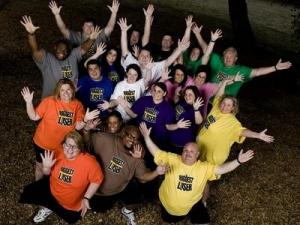Beavis and Butthead giggled their way onto T.V. sets all across America, everyone was dancing to the hip sounds of The Macarena, and droves of SUV’s started roaming the streets all across the country.
It was the 1990s.
In comes Benny.
His was a Ford Explorer or other. It was oversized, commanding, and ornate. All the qualities he desired but lacked.
He parked the alter ego in a handicapped spot and made his way to the gym.
The door swiftly came open and there stood Benny in the threshold. The entrance was somewhat dramatic. Frothy smoke bellying up all around him was the only effect missing for a complete scene.
Benny was dressed to the nines. He was sporting a new urban street track suit. Thoughts of him auditioning for a role in the hit series The Sopranos or just getting back from a hip hop convention crossed our minds.
He was styling.
“Wasup” was voiced by the nylon pimp. We could only exchange welcomes with grunts; squats were taking their toll on us.
Joking, sarcasm, and brotherly love was the atmosphere and the hot topic quickly turned to Benny’s new get-up. It was a boisterous sort of green color with purple stripes parading down the forepart of his jacket. He must have been professionally fitted, for it fit him like a glove.
We on the other hand were fashion wrecks. Our fashion statement was that of mismatched, torn, and chalk-sooted garb.
Versace would have turned over in his grave.
We weren’t there to look good. We were there to lift.
Presses were up next so we huddled around the sacramental bench and began our ritualistic strength ceremony. Numbers were blared out, plates were exchanged, and effort emitted.
Just then a ring filled the air.
Benny dipped a hand inside his jacket pocket and pulled out his new mobile phone. It was the beginning of the (perpetual) contact era and Benny bought into it.
An invitation to join us was almost exuded but…
we quickly realized that curling his jittery phone up to his ear with each call made or received was the only kind of lifting Benny would be performing that day.
Benny had it all wrong.
Like Benny, I believe most people have it all wrong too.
I believe that too many of us spend too much of our time and energy on the superficial aspects of self (having) rather than core substance (being).
In Karl Marx’s view, the problem with having is that
it produces a false path to happiness through “commodity fetishism”
(Marx 1867). In commodity fetishism goods are worshipped by consumers and
believed to have magical powers to bring happiness, provoking a pervasive
expectation that happiness lies in the next purchase, or, “I would be
happy if I could just have …” (Belk).
Here’s an example of the feeling of identity invested in material objects according to Ames. I believe many of us secretly hold these exact feelings-
They knew from experience that purchasing a major
object could be a significant and momentous occasion in itself, a time of
heightened positive emotions and feelings of well-being and importance a major
purchase would transform them in their own eyes and in the eyes of others. They
would become worth more . . . and acquire greater status. By so doing they
would receive more respect and deference from others which would, in turn, make
them feel better about themselves. [pp. 30 -31]
Yet another example of misdirected, better yet false, intentions can be seen in the footage and lyrics Billionaire by Travis McCoy featuring Bruno Mars.
This is the no talent garbage that the music industry is pumping out in order to convince society, especially its vulnerable youth, false aspirations to a happy life.
Money, power, and fame equals happiness right?
Bruno Mars
I wanna be a billionaire so frickin bad
Buy all of the things I never had
I wanna be on the cover of Forbes Magazine
Smiling next to Oprah and the Queen
Oh every time I close my eyes
I see my name in shining lights, yeaaah
A different city every night oh I swear
The world better prepare for when I’m a billionaire
Travie McCoy
Yeah I would have a show like Oprah
I would be the host of
Everyday Christmas give Travie a wish list
I’d probably pull an Angelina and Brad Pitt
and adopt a bunch of babies that ain’t never had sh!t
Give away a few Mercedes like here lady have this
And last but not least grant somebody their last wish
It’s been a couple months since I’ve single so
You can call me Travie Claus minus the ho-ho
Get it, I’d probably visit where Katrina hit
And damn sure do a lot more than FEMA did
Yeah can’t forget about me stupid
Everywhere I go Imma have my own theme music
Bruno Mars
Oh every time I close my eyes
I see my name in shining lights
A different city every night oh I swear
The world better prepare for when I’m a billionaire
(oooh ooh) when I’m a Billionaire
(oooh ooooh)
Travie McCoy
I’ll be playing basketball with the President
Dunking on his delegates
Senator … his political etiquette
Toss a couple milli in the air just for the heck of it
But keep the fives, twenty’s …completely separate
And yeah I’ll be in a whole new tax bracket
We in recession but let me take a crack at it
I’ll probably take whatever left and just split it up
So everybody that I love can have a couple bucks
And not a single tummy around me
Would know what hungry was
Eating good sleeping soundly
I know we all have a similar dream
Go in your pocket pull out your wallet
And put it in the air and sing
Bruno Mars
I wanna be a billionaire so frickin bad (so bad)
Buy all of the things I never had
I wanna be on the cover of Forbes Magazine
Smiling next to Oprah and the Queen
Oh every time I close my eyes
I see my name in shining lights
A different city every night oh I swear
The world better prepare for when I’m a billionaire
(oooh ooh sing it) when I’m a Billionaire
(oooh ooooh)
I wanna be a billionaire so frickin bad
End-
What is the message that “Travie” or more specifically the music industry is trying to convey?
That happiness is only attainable if you have a boatload of money.
Come on!
Substance, according to my beliefs, is the true makeup of who we are and is where applied effort should be focused.
Working on bettering our integrity, authenticity, civility, generosity, sensitivity, and a host of other personal traits should be what concerns us.
We should be doing the complete OPPOSITE of what is expected of us from western civilization.
An over excess of possessions, material, can foster greed, self-indulgence, selfishness, etc.
Remember-
The greater the tendency for the person to rely on material possessions to
constitute self, usually the greater the emptiness in sense of self is likely
felt (Belk).
References
Ames, K. L. (1984). Material culture as nonverbal communication: a historical case study. In American Material Culture: The Shape of Things Around Us, ed. Edith Mayo, pp. 25-47. Bowling Green, OH: Bowling Green University Popular Press.
Belk, Russell. “Are We What We Own?” Web.
http://www.writing.ucsb.edu/faculty/tingle/courses/W2ACE/AREWE2.pdf.
Belk, Russell. (1988). Possessions and the extended self. Journal of Consumer Research 15 (2):139-168.





















